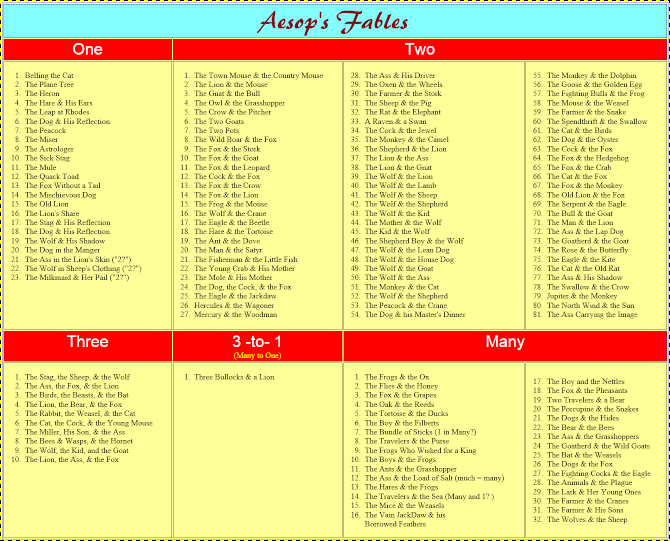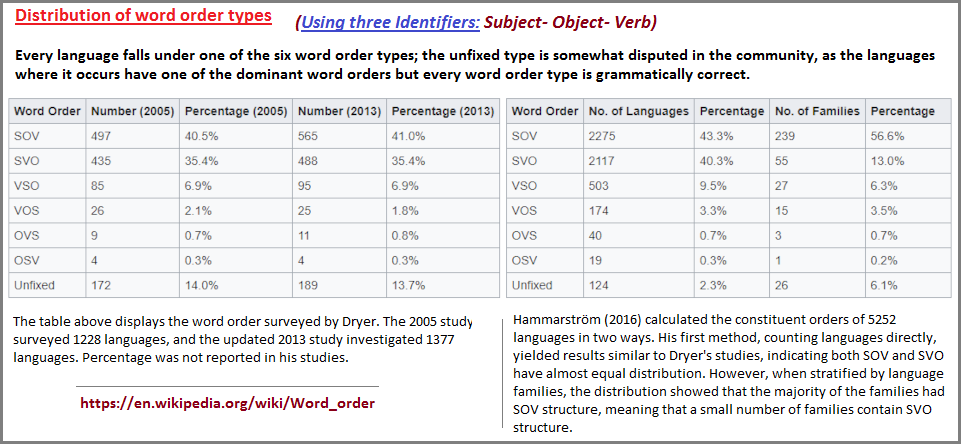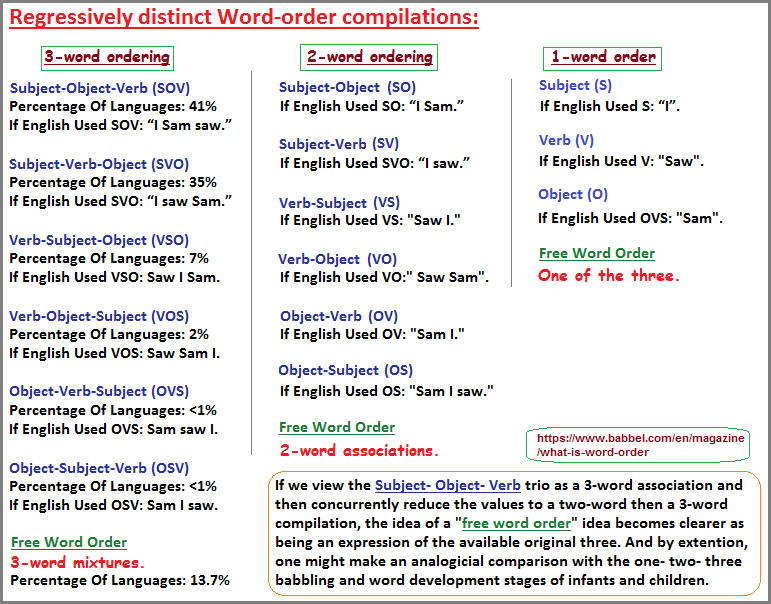("1- 2- Many" profiling Introduction)
Progressive Thinkers as of 12/1/2022
|
| |||||||||||||||||||||||||||||||||||||||||||||||||||||||||||||||||||||||||||||||||||||||||||||||||||||||||||||||||||||||||||||||||||||||||||||||||||||||||
In the exploration of the "1- 2- Many" idea I speak of in different contexts, it is a good idea for the reader to have a basic understanding of what I am talking about. Fortunately, analyzing the collection of Aesop's Fables provides an easily understood representation.
Here is the following image in pdf form: Aesop's Fables.pdf. The smaller image gives the reader an easy survey of how I have arranged the "1- 2- Many" categories into different listings. While the categories might give the impression of being too general and broad, nonetheless this is the recurring theme that the human mind is using, albeit with different words and symbols in different contexts. The repetition of such a small quantity of themes is similar to the small quantities we find being used in multiple instances such as a triplet code in genetics, the "threes" in physics, the Monad, Dyad, Triad/Plurality in conventional (Western) Philosophy, the Oneness, Duality, Many theme in Metaphysical (Eastern) philosophy, the One god- Duality- Trinitarian/Triune, of Western religion, etc...

Your underlying consciousness from which a higher consciousness can only emerge, is trying to speak to you. Some people listen and alter the meaning into a religious context, while others focus what is being symbolically expressed... towards a life-directing philosophy as can be seen in Eastern religions. Others get intermittent impressions out of which the idea of a New Age is on the verge of dawning. And yet others applying the pattern of symbolic articulation into their respective interests, be it mathematics, music, dance, art, gambling, writing, or some other profession within which typically has its own jargon, vernacular, idioms and traditions of interpretation.
The collection of Aesop's fables provides an excellent model for introducing the reader to (a "threes" tool by which) the "1- 2- Many" frame can be applied to the ideas found in all subjects, thus revealing the existence of a Standard Cognitive model for humanity; and thus enabling us to monitor changes in cognition over time... with respect to identifying deteriorations, mutations, experimentation, idiosyncrasies, or that mental activity which some may come to thing to be an expression of growth... if not an expanding consciousness. Aesop's fables used in the present context will enable many different people from many different walks of life to view and monitor human mental activity, and not leave it to some assumed repository of experts to be a filtering mechanism for establishing validity of an existing cognitive profile. The so-called experts don;t know everything.
We can find the pattern in the development of counting, in art, social structures, physics, mathematics, advertising, military strategy, playing checkers, chess, poker, shooting billiards, football/basketball/baseball (etc.) strategies, experimentation, gang behavior, songs, business strategies, experimentation, sexual behavior, report writing, etc... In the case of a "3 -to- 1", one might view this as a "Many -to- One", and larger denominations would remain in the "Many" segmentation, and is consistent with that seen in some biological circumstances though not customarily identified within the framework I am using as a scaffolding approach at erecting the idea of a Standard Cognitive Profile, where exceptions may occur in actuality, or just in the mind of a given researcher who is anxious to describe some flaw in any pattern presented to them, without considering the notion of their type of thinking as being part of a recurring segment in the profile.
In most instances it appears that people use a "3, or more than 3" point of demarcation to be alternatively viewed as a "Many" category, though don't be surprised if you find someone who insists on using more than 1, or a more than 2, as a point beyond which they reference the idea of "Many". By identifying a recurring model of thinking being used by all humans, whether a given person, group, culture, etc., uses the entire "1- 2- Many" scale (ruler) or even in this sequencing arrangement. Like the musical chairs game we see in Word Order-ing (involving the three: Subject- Object- Verb), the "1- 2- Many" frame could be rearranged like a person who changes the positions of furniture in their house, items in a shed or garage, or rearranges items in a kitchen, bathroom cabinet, wallet, tool box, horse stable, garden, bookcase, characters in a story, etc... If there are changes taking place with the human species', we need to know why. Does it speak of something good or bad or repetitiously stagnant, thus leaving humanity vulnerable to alteration by environmental events, disease, etc... In other words, does the situation present humanity as being in a cave, open air, or stuck in some muck?


I took the list of Aesop's fables from here: Library of Congress: A list of Aesop's Fables, and subjected the list to a "one, two, Many: profiling which includes an example of the "3-to-1" grouping pattern, and came up with the following list. Generally, if a word was pluralized I considered it to reference "many", though one might say that "2" items can be viewed as a plurality in some instances. Also, I put "The Milkmaid & Her Pail" selection into the single category but it might the better be placed in the "two" column, because the pail is not a physical extension of the person, per se, though an animal and their ears are. Anyway, while there are multiple ways of categorizing the list: by animal types, people, insects, reptiles, etc., my intent is to show that the basic cognitive themes aligned with numerical indices can be deduced. The abundance of "two-patterned" ideas may well reference the dominant prevailing context in which Aesop lived, as it might have been the case in Ancient China with the advent of the Yin/Yang idea, though in an Indo-European context the development of a two-patterned based Mathematics was being unleashed in academic circles. I do not know if this same categorizing of other areas (mythology, religion, politics, philosophy, art, music, etc...) would yield a similar patterning profile in that the "2" would be dominant as well. However, because we can find an abundance of "two-patterned" ideas in mathematics, the mathematics being generated at the time needs to be taken into account as a representative corollary taken place at a later time and context. In other words, because of a similarity of design, the dominance of the "two" profiled by the Chinese "yin/yang" came to be expressed later on in Europe hen the European brain matured beyond its expressed ignorance, since the Chinese were much more advanced in many ways than the rest of world's human populations... or so it appears by reading some accounts of history.
If we accept the task of surveying multiple religions and their counter-part ideological orientations called Eastern Philosophies, though the philosophies appear to be inclined more-so towards practical personal and social reforms (along with metaphysical considerations) than I think Western religions are because of the very many activities involving combativeness during different eras which western religions have engaged in (for example the crusades and an absence of a similar historical referencing for Eastern philosophies); there is a distinction to be made on how the values of 1, 2 (3 -to/in/from/with- 1), and Many can be described. I think the numbers are reflective of a basic cognitive code being expressed in different way during different eras and highlight a repetitiveness leading me to conclude we are in the midst of a "Conservation of Number" usage due to constraints put on our biology by an incrementally deteriorating environment. Indeed, the "1- 2- Many" formula can be seen in basic biology in the form of a single cell- divides by two- producing Many cells... but has a limitation in so doing, and there is only a modicum of regeneration.
In some case for some subjects, I have encountered what appear to be transitional representations of ideological focusing such as between 1 and 2; 2 and 3 and 3 and Many. In several instances we humans refer to "3 or more" as a plurality, or in other words a "Many" that might be alternatively described as much, more, plenty, heap, few, some, bunch, pile, X, XX, XXX-large, infinity, etc... Hence, while I have singled out the only example of a 3 -to-1 occurring in the Aesop listings, it may indicate a transitioning moment to devise a multiplicity/plurality with distinction.
Much like the usage of the Christian concept of the Trinity which is sometimes referenced as "3 persons in 1 godhead", otherwise interpreted to me that it is a singular model of multiplicity. However, as I have stated before, the Trinity appears to be a left-over orientation of a planetary orientation once used by Pagan Nature worshipers who were more honest and observant about Nature to the extent they had no qualms about deducing the Sun as having 3 "aspects" which we call dawn-noon-dusk. The absence of literacy, knowledge (along with a belief in superstition and magic) and a much closer attendance to Natural events by a people who "lived off the land" in a pristine mode of day-to-day experience... as opposed to all the artificiality people of today are subjected to; the 3 daily solar phases would easily be viewed as an important theme. People can not see the origin of the Trinity as part of some ancient Nature worship because they more often turn to an artificial source called a bible, Koran, or other so-called sacred writings. Such people no long want to trust their own perceptions and judgments. But if you take such artificial sources away, then they seek out some other form of artificiality, like so very much of what is part of so many lives. Taking a walk in a park or stroll on a beach is a far cry from living hand-to-mouth off of a piece of acreage were there are no existing technologies and you are not even aware of such technologies as well.
Those who seek to "get back to Nature" only do so to a certain extent. Because of the prevailing level of knowledge exhibited in the common person's speech patterns and topic of conversations, there is no way for any of us to actually get back to the type of Nature our forbearers lived with. Hence, to speak of the three phases (or "moments") of the Sun as having influenced the idea of the present day Trinity derived from pagan Nature worshiping orientations (and may have also influenced the triplet code of DNA many billions of years ago when the Earth was spinning much faster thus creating a triple-patterned strobe-light branding iron effect on vulnerable biological substrates); is too fare removed from a mentality whose majority of interests and day-to-day mental exercises involve an appreciable accounting of artifiicialized collections of ideas. For example, use of the electric light as a substitute for daylight, the many artificially-created foods and drinks, modern medicine artificialities, entertainment artificialities, etc... In fact, some people have never thought about how much of their life is actually based on some artificiality such as the clothes they wear, their false teeth, joint replacements, artificial cooling and heating, etc... I'm not saying these things are not needed, but they set people up from being unable to recognize the more pristine origin from which something has arisen.
With respect to the Trinity, the "3 -in- 1" model of thinking shows up elsewhere as well. It is not restricted to the Christian trinity as this list shows: 3 to 1 ratios page A. One point which needs to be brought up is that if the pattern is related to the influence of the three solar events (dawn- noon- dusk), and they are incrementally "fusing" due to the expansion of the Sun as it deteriorates(or at least spreading apart (elongating) due the Earth's slowing rotation), then we should be able to recognize the same event taking place with biological extensions thereof... but would not think of it unless someone like me shirked the conventionalities being presented by both religion and science.
Whereas the reader might want to argue that if the Sun has a triple pattern influence on biology, and thus physiology and thus ideology, where are the other "threes" ideas? Instead of orientating yourself to a singular major pattern-of-three, some people use "many" smaller ones, while others use just a few. Does the reader know which their's are/is? Perhaps you prefer to use dichotomies and not realize you use three major ones or use them in three different situations, etc... Then again, another may like the concept of singularity and uses it on a regular three-moments basis without even being aware that they are.
Date of Origination: Wednesday, 11th January 2023... 4:48 AMDate of Initial posting: Saturday, 14th January 2023... 12:36 PM